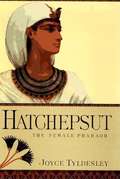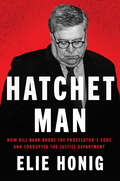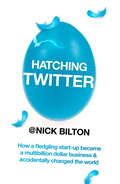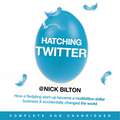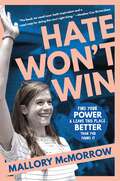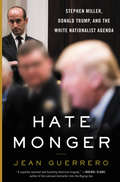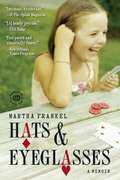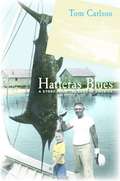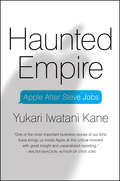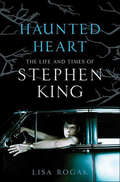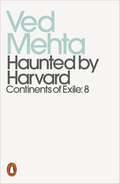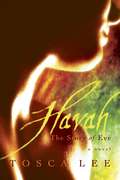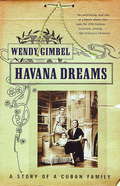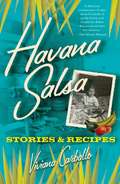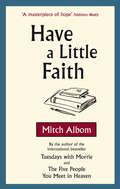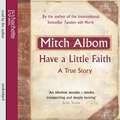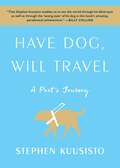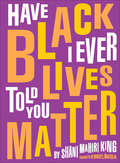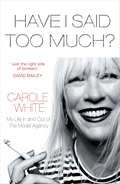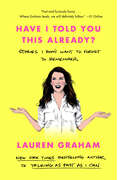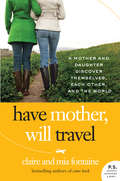- Table View
- List View
Hatch, Match, and Dispatch: The Life and Times of The Almost Reverend William Billow
by William BillowBeing a priest is likened to being a shepherd. People do, from time to time, need a poke here or a prod there. But mostly, they need to know someone is watching out for them. Rev. William Billow has been that gentle guiding hand for multiple communities across the nation, but he is best known for his services in Washington, DC, from St. Albans School to Washington Cathedral. He practices &“the ministry of presence,&” witnessing and overseeing the baptisms, weddings, and funerals of the members of his flocks. As he moves from community to community, his story does not fail to enlighten and inspire.
Hatchepsut: The Female Pharaoh
by Joyce TyldesleyQueen - or, as she would prefer to be remembered King - Hatchepsut was an astonishing woman. Brilliantly defying tradition she became the female embodiment of a male role, dressing in men's clothes and even wearing a false beard. Forgotten until Egptologists deciphered hieroglyphics in the 1820's, she has since been subject to intense speculation about her actions and motivations. Combining archaeological and historical evidence from a wide range of sources, Joyce Tyldesley's dazzling piece of detection strips away the myths and misconceptions and finally restores the female pharaoh to her rightful place.
Hatchet Man: How Bill Barr Broke the Prosecutor's Code and Corrupted the Justice Department
by Elie HonigThis national bestselling account of Bill Barr’s tenure as Trump’s attorney general is “essential reading for all who cherish the rule of law in America” (George Conway).“Written with all the color and pacing of a legal thriller” (Variety), this book by a former federal prosecutor and CNN senior legal analyst exposes William Barr as the most corrupt attorney general in modern U.S. history. Elie Honig draws on his own experience as a prosecutor at DOJ to show how, as America’s top law enforcement official, Barr repeatedly violated the Department’s written rules, and those vital, unwritten norms and principles that comprise the “prosecutor’s code,” resulting in an unprecedented abuse of power. Barr, he states, was corrupt from the beginning: His first act as AG was to distort the findings of Special Counsel Robert Mueller, earning a public rebuke for his dishonesty from Mueller himself and, later, from a federal judge. Then, Barr tried to manipulate the law to squash a whistleblower’s complaint about Trump’s dealings with Ukraine—the report that eventually led to Trump’s first impeachment. He later intervened to undermine his own DOJ prosecutors on the cases of Trump allies Michael Flynn and Roger Stone, and fired the U.S. Attorney for the Southern District of New York under false pretenses. Finally, Barr amplified baseless theories about massive mail-in ballot fraud, pouring gasoline on the dumpster fire battle over the 2020 election results and contributing to the January 6 insurrection that led to Trump’s second impeachment.In Hatchet Man, Honig proves that Barr trampled the two core virtues that have long defined the DOJ and its mission: credibility and independence—and explains what we must do to prevent this from ever happening again.“Indicts Barr for treating his role as that of a personal enforcer for the president rather than the leader of an independent Justice Department . . . for readers looking for an accessible overview of Barr’s time as attorney general—or dizzied by the sheer volume of scandals that took place during the Trump presidency—Honig provides a useful rundown.” —The Washington Post“A comprehensive indictment of one of the most controversial figures of the Trump administration.” —Publishers Weekly“A resounding excoriation of an unquestionably corrupt operator.” —Kirkus Reviews
Hatching Twitter: A True Story of Money, Power, Friendship and Betrayal
by Nick Bilton'A tale of Machiavellian plots and coups d'etat, it's just all so gripping' Chris Evans, BBC Radio 2THE ULTIMATE 21ST CENTURY BUSINESS STORYSince 2006, Twitter has grown from the accidental side project of a failing internet start-up, to a global icon that by 2013 had become an $11.5bn business. But the full story of Twitter's hatching has never been told before.In his revelatory new book, New York Times journalist Nick Bilton takes readers behind the scenes of Twitter as it grew at exponential speeds, and inside the heads of the four hackers who created it: ambitious millionaire Evan Williams; tattooed mastermind Jack Dorsey; joker and diplomat Biz Stone; and Noah Glass, the shy but energetic geek who invested his whole life in Twitter, only to be kicked out and expunged from the company's official history.Combining unprecedented access with exhaustive investigative reporting, and drawing on hundreds of sources, documents and internal emails, New York Times' bestseller HATCHING TWITTER is a blistering drama of betrayed friendships and high-stakes power struggles. A business story like no other, it will shock, expose and inspire.
Hatching Twitter: A True Story of Money, Power, Friendship and Betrayal
by Nick BiltonTHE ULTIMATE 21ST CENTURY BUSINESS STORYEv told Jack he had to 'chill out' with the deluge of media he was doing. 'It's bad for the company,' Ev said. 'It's sending the wrong message.' Biz sat between them, watching like a spectator at a tennis match.'But I invented Twitter,' Jack said.'No, you didn't invent Twitter,' Ev replied. 'I didn't invent Twitter either. Neither did Biz. People don't invent things on the Internet. They simply expand on an idea that already exsists.'Since 2006, Twitter has grown from the accidental side project of a failing internet start-up, to a global icon that by 2013 had become an $11.5bn business. But the full story of Twitter's hatching has never been told before.In his revelatory new book, New York Times journalist Nick Bilton takes readers behind the scenes of Twitter as it grew at exponential speeds, and inside the heads of the four hackers who created it: ambitious millionaire Evan Williams; tattooed mastermind Jack Dorsey; joker and diplomat Biz Stone; and Noah Glass, the shy but energetic geek who invested his whole life in Twitter, only to be kicked out and expunged from the company's official history.Combining unprecedented access with exhaustive investigative reporting, and drawing on hundreds of sources, documents and internal e-mails, HATCHING TWITTER is a blistering drama of betrayed friendships and high-stakes power struggles. A business story like no other, it will shock, expose and inspire.(P)2013 Penguin Group USA
Hatching: Experiments in Motherhood and Technology
by Jenni QuilterA provocative examination of reproductive technologies that questions our understanding of fertility, motherhood, and the female bodySince the world&’s first test-tube baby was born in 1978, in vitro fertilization has made the unimaginable possible for millions of people, but its revolutionary potential remains unrealized. Today, fertility centers continue to reinforce conservative norms of motherhood and family, and infertility remains a deeply emotional experience many women are reluctant to discuss. In this vivid and incisive personal and cultural history, Jenni Quilter explores what it is like to be one of those women, both the site of a bold experiment and a potential mother caught between fearing and yearning. Quilter observes her own experience with the eye of a critic, recounting the pleasures and pains of objectification: how medicine mediates between women and their bodies, how marketing redefines pregnancy and early parenthood as a set of products, how we celebrate the &“natural&” and denigrate the artificial. With nuance, empathy, and a fierce intellect, Quilter asks urgent questions about what it means to desire a child and how much freedom reproductive technologies actually offer. Her writing embraces the complexities of motherhood and the humanity of IVF: the waiting rooms, the message boards, and the genetic permutations of what a thoroughly modern family might mean.
Hate Won't Win: Find Your Power and Leave This Place Better Than You Found It
by Mallory McMorrowIn this urgent expansion of her viral speech, Michigan Senator Mallory McMorrow details her unlikely journey into politics with a front-row seat to democracy at its breaking point—then outlines the tangible, proven steps that anyone can take to build community, fight for what's right, and create real, lasting change. Mallory McMorrow was on the verge of giving up. She knew the work of legislating wouldn&’t be easy, but she hadn&’t been expecting an insidious culture of sexual harassment, armed protestors storming the state Capitol, or colleagues who had zero interest in reaching across the aisle to get anything meaningful done. Where could one even start? But then fate forced her hand. A Senate colleague called her out as a &“groomer&”—for standing up for LGBTQ+ kids and fighting against attempts to whitewash history in our schools. In response, Mallory delivered a blistering rebuke with a speech from the Michigan Senate floor that reverberated throughout the country and the world, leading many long-jaded political pundits to hail Mallory&’s action as a &“blueprint&” for fighting back. Here, Mallory pulls back the curtain on what it&’s like to work in today&’s politic arena, rife with conspiracy theories and division—yet emerges clear-eyed, offering actionable steps for building community and creating change.Hate Won't Win is a step-by-step guide for anyone who&’s fed up with the divisiveness in American politics, and anyone who wants to make a real difference but has no idea where to start—a blueprint for creating the communities and country we want to see.
Hatemonger: Stephen Miller, Donald Trump, and the White Nationalist Agenda
by Jean Guerrero“A vital book for understanding the still-unfolding nightmare of nationalism and racism in the twenty-first century.” —Francisco Cantú, author of The Line Becomes a RiverStephen Miller was one of the most influential advisors in the White House. He crafted Donald Trump’s speeches, designed immigration policies that banned Muslims and separated families, and outlasted such Trump stalwarts as Steve Bannon and Jeff Sessions. But he’s remained an enigma.Until now. Emmy- and PEN-winning investigative journalist and author Jean Guerrero charts the thirty-four-year-old’s astonishing rise to power, drawing from more than one hundred interviews with his family, friends, adversaries and government officials.After being radicalized as a teenager and attending Duke University, Miller served Tea Party congresswoman Michele Bachmann and nativist Alabama Senator Jeff Sessions. Recruited to Trump’s campaign, Miller met his idol. Having dreamed of Trump’s presidency before he even announced his decision to run, Miller became his senior policy advisor and speechwriter. Together, they stoked dystopian fears about the Democrats, “Deep State” and “American Carnage,” painting migrants and their supporters as an existential threat to America. While Trump railed against illegal immigration, Miller crusaded against legal immigration. He targeted refugees, asylum seekers and their children, engineering an ethical crisis for a nation that once saw itself as the conscience of the world. Miller rallied support for this agenda, even as federal judges tried to stop it, by courting the white rage that found violent expression in tragedies from El Paso to Charlottesville.Hatemonger unveils the man driving some of the most divisive confrontations over what it means to be American—and what America will become.
Hats & Eyeglasses
by Martha FrankelMartha Frankel grew up in a warm, loving family of diehard gamblers, where her father?s poker games and her mother?s mah-jongg blended happily with big pots of delicious food and endless gossip. As kids, she and her cousins bet on everything?from which of their Weight Watching mothers would lose the most to who could hold their breath longest underwater or eat the most matzo. But once Frankel left for college and later became a successful entertainment journalist, gambling didn?t factor much into her life. She thought her family legacy had passed her by. In this ?fast-paced and amazingly funny? (The Times- Picayune) memoir, Frankel traces her love affair with poker, an obsession that didn?t hit until her mid-forties. And she was good at poker. Frankel won routinely, whether she was playing in her Wednesday-night poker game or in one of the seedy, out-of-the-way rooms she always managed to find when on assignment. But all this changed when she discovered online poker. It was the beginning of what one of her uncles called ?hats and eyeglasses,? a term used to describe those times when you?re losing so bad your ship is sinking until all that?s left on the water?s surface are your hat and eyeglasses. By turns hilarious and heartbreaking, Hats & Eyeglasses is a tale of passion, addiction? and those times in life when we almost lose our shirt. .
Hatteras Blues
by Tom CarlsonTom Carlson tells the story of Ernal Foster and the Foster family of Hatteras Village, who gave birth to what would become the multi-million dollar charter fishing industry on the Outer Banks. Today, Ernal's son, Captain Ernie Foster, struggles to keep the family business alive in a time of great change on the Banks. Within the engaging saga of the rise and decline of one family's livelihood, Carlson relates the history and transformation of Hatteras Village and the high-adrenaline experience of blue-water sportfishing and the industry that surrounds it. Hatteras Blues is their story--a story of triumph and loss, of sturdy Calvinist values and pell-mell American progress, and of fate and luck as capricious as the weather.
Haunted Empire
by Yukari Iwatani KaneFormer Wall Street Journal technology reporter Yukari Iwatani Kane delves deep inside Apple in the two years since Steve Jobs's death, revealing the tensions and challenges CEO Tim Cook and his team face as they try to sustain Jobs's vision and keep the company moving forward.Steve Jobs's death raised one of the most pressing questions in the tech and business worlds: Could Apple stay great without its iconic leader? Many inside the company were eager to prove that Apple could be just as innovative as it had been under Jobs. Others were painfully aware of the immense challenge ahead. As its business has become more complex and global, Apple has been subject to intense scrutiny, much of it critical. Maintaining market leadership is crucial as it tries to conquer new frontiers and satisfy the public's insatiable appetite for "insanely great" products.Based on more than two hundred interviews with current and former executives, business partners, Apple watchers, and others, Haunted Empire is an illuminating portrait of Apple today that offers clues to its future. With nuanced insights and colorful details that only a seasoned journalist could glean, Kane goes beyond the myths and headlines. She explores Tim Cook's leadership and its impact on Jobs's loyal lieutenants, new product development, and Apple's relationships with Wall Street, the government, tech rivals, suppliers, the media, and consumers. Hard-hitting yet fair, Haunted Empire reveals the perils and opportunities an iconic company faces when it loses its visionary leader.
Haunted Heart: The Life and Times of Stephen King
by Lisa RogakA fascinating look at the life of the author who created such modern classics as Carrie, IT, and The Shining.One of the most prolific and popular authors in the world today, Stephen King has become part of pop culture history. But who is the man behind those tales of horror, grief, and the supernatural? Where do these ideas come from? And what drives him to keep writing at a breakneck pace after a thirty year career? In this unauthorized biography, Lisa Rogak reveals the troubled background and lifelong fears that inspire one of the twentieth century's most influential authors. King's origins were inauspicious at best. His impoverished childhood in rural Maine and early marriage hardly spelled out the likelihood of a blossoming literary career. But his unflagging work ethic and a ceaseless flow of ideas put him on the path to success. It came in a flash, and the side effects of sudden stardom and seemingly unlimited wealth soon threatened to destroy his work and, worse, his life. But he survived and has since continued to write at a level of originality few authors could ever hope to match. Despite his dark and disturbing work, Stephen King has become revered by critics and his countless fans as an all-American voice more akin to Mark Twain than H. P. Lovecraft. Haunted Heart chronicles his story, revealing the character of a man who has created some of the most memorable---and frightening---stories found in literature today. Stephen King on Stephen King:"I'm afraid of everything.""As a kid, I worried about my sanity a lot.""I am always interested in this idea that a lot of fiction writers write for their fathers because their fathers are gone.""Writing is an addiction for me.""I married her for her body, though she said I married her for her typewriter.""When you get into this business, they don't tell you you'll get cat bones in the mail." "You have to be a little nuts to be a writer.""There's always the urge to see somebody dead that isn't you."
Haunted by Harvard: Continents of Exile: 8 (Penguin Modern Classics)
by Ved MehtaBook 8 in Ved Mehta's Continents of Exile series. Nearly 50 years in the making, Continents of Exile is one of the great works of twentieth-century autobiography: the epic chronicle of an Indian family in the twentieth century. From 1930s India to 1950s Oxford and literary New York in the 1960s-80s, this is the story of the post-colonial twentieth century, as uniquely experienced and vividly recounted by Ved Mehta.Veritas continues Mehta's journey through education: this time as a Ph.D. student and Residential Fellow at Harvard. His experience illustrates the dramatic changes in institutional habits and behaviour that were to take places in the late 1960s, as well as how dramatically out-of-touch many senior lecturers were to the societal mood around them.
Haunted narratives
by Therese Steffen Tiina Kirss Gabriele Rippl Philipp Schweighauser Margit SutropExploring life writing from a variety of cultural contexts, Haunted Narratives provides new insights into how individuals and communities across time and space deal with traumatic experiences and haunting memories. From the perspectives of trauma theory, memory studies, gender studies, literary studies, philosophy, and post-colonial studies, the volume stresses the lingering, haunting presence of the past in the present. The contributors focus on the psychological, ethical, and representational difficulties involved in narrative negotiations of traumatic memories.Haunted Narratives focuses on life writing in the broadest sense of the term: biographies and autobiographies that deal with traumatic experiences, autobiographically inspired fictions on loss and trauma, and limit-cases that transcend clear-cut distinctions between the factual and the fictional. In discussing texts as diverse as Toni Morrison's Beloved, Vikram Seth's Two Lives, deportation narratives of Baltic women, Christa Wolf's Kindheitsmuster, Joy Kogawa's Obasan, and Ene Mihkelson's Ahasveeruse uni, the contributors add significantly to current debates on life writing, trauma, and memory; the contested notion of "cultural trauma"; and the transferability of clinical-psychological notions to the study of literature and culture.
Havah: The Story of Eve
by Tosca LeeEve, exiled to a life outside paradise, nears death. As she waits, she recounts the story of her creation and a cruel existence. Revisit the birth of humankind through the eyes of the first woman ever to live.
Havana Dreams
by Wendy GimbelA fascinating, powerfully evocative story of four generations of Cuban women, through whose lives the author illuminates a vivid picture--both personal and historical--of Cuba in our century."When I want to read a culture," writes Wendy Gimbel in her prologue, "I listen to stories about families, sensing in their contours the substance of larger mysteries." And certainly in the Revuelta family she has found a source of both mystery and revelation. At its center is Naty: born in 1925, educated in the United States, a socialite during the Batista era, who after marriage to a prominent doctor and the birth of a daughter became intoxicated with Castro and his revolution (here, published for the first time, are the letters they exchanged while he was in jail). Though her husband and daughter immigrated to the United States after Castro's victory, Naty remained in Cuba to raise her second child, Castro's unacknowledged daughter, only to be ultimately confronted by his dismissive, withering judgment: "Naty missed the train." Her two daughters, one of whom settles well into life in America, while the other never recovers from her father's intransigent repudiation of her; her granddaughter, who Naty desperately believes will return to Cuba when--not if--Castro is removed from the island; and her mother, an unregenerate reactionary: these are the lives that complete this extraordinary story.Each of the women is irrevocably marked with a part of the island's terrible and poignant tale, and Wendy Gimbel has created a rich and intense narrative of their lives and times. Havana Dreams leaves us with an indelible impression of familial obligation and illicit love; of the heady but doomed romanticism of revolution; and of the profound consequences of Cuba's contemporary history for the ordinary and most intimate lives of its people.From the Hardcover edition.
Havana Salsa
by Viviana CarballoWith more than seventy mouthwatering recipes, this vibrant memoir by food writer Viviana Carballo shares the Havana of her childhood -- warm nights, pounding surf, energetic music, and the memorable meals that both nourished and delighted her and her family throughout the years. In the 1940s and 1950s, at the height of government corruption, Havana was a nonstop party. Food and music defined the culture, and the pervading sensuality -- the physical beauty of the city itself with its frisson of danger -- made it a magnet for tourists, gangsters, and the world's most glamorous celebrities. This was the Cuba of Viviana Carballo's magical childhood and adventurous adolescence. Born in 1939, she was the only child of a stylish and spirited woman and a handsome astrologer and writer, whose passion for food ignited Carballo's own taste for the exotic, eclectic cuisine for which Havana had become known. By the time she reached her teenage years, sultry nights dancing at the Tropicana and rubbing elbows with the likes of Ernest Hemingway, Meyer Lansky, and Guillermo Cabrera Infante nourished her hunger for the rhythm and creativity pulsating throughout her beloved city. But all of that changed in 1959, when Fidel Castro took command of this rollicking paradise, turning it into a country marked by extreme poverty, food shortages, power outages, and daily water stoppages. In 1961, Carballo left her beloved country with the clothes on her back and no idea when she would ever see her husband, family, or friends again. It is only through her memories that she has ever returned to the place that defined her. Havana Salsa is a collection of stories about her large, extended family, a rather eccentric group who conducted their lives against the extraordinary backdrop of Havana, and of her own experiences amid the city's former delicious decadence. It also showcases the food and recipes Carballo associates with each delightful family memory, beginning with her childhood in the forties (calabaza fritters, sweet plantain tortillas, and oxtail stew), through the sensual fifties (roast shoulder of lamb, Cuban bouillabaisse), and then the first eighteen months of Castro's revolution (mango pie, pollito en cazuela, and papas with chorizo). Havana Salsa tells the history of Carballo's Havana as only she can -- through the intimate and unifying experience of food, family, and friends.
Have A Little Faith
by Mitch AlbomFROM THE MASTER STORYTELLER WHOSE BOOKS HAVE TOUCHED THE HEARTS OF OVER 40 MILLION READERS'Mitch Albom sees the magical in the ordinary' Cecilia Ahern__________Will you do my eulogy?With those words, Mitch Albom begins a remarkable eight-year journey to honour the request of a beloved rabbi.Feeling unworthy of such a responsibility, Albom sets out to know the man better and unexpectedly finds himself drawn to two seemingly disparate worlds: Christian and Jewish, African-American and white, impoverished and well-to-do. Over the course of his exploration, he is compelled to consider life's biggest questions.On Albom's voyage of discovery he explores forgiveness, doubt and how to endure when the unimaginable happens. Have a Little Faith is the result: a book about the indominable strength of the human spirit and the power of genuine connection.__________WHAT READERS SAY ABOUT HAVE A LITTLE FAITH'You cannot fail to be uplifted by this touching story that I will continue to read again and again''A beautiful book full of hope''Albom writes with pure honesty, passion and sensitivity. I get lost in his books''A treasure . . . Beautifully written and uplifting! Wow!''Sweet, simple, effortless writing'
Have A Little Faith
by Mitch AlbomWill you do my eulogy?With those words, Mitch Albom begins his long-awaited return to non-fiction. His journey to honour the last request of a beloved clergyman ultimately leads him to rekindle his own long-ignored faith. Albom spends years exploring churches and synagogues, the suburbs and the city, the 'us' versus 'them' of religion. Slowly, he gravitates to an inner-city pastor of a crumbling church that houses the homeless, and is stunned at how similar belief can be. As his own beloved cleric slowly lets go, Albom writes his final farewell, having learned that a faithful heart comes in many forms and places.
Have Dog, Will Travel: A Poet's Journey
by Stephen Kuusisto<P>In a lyrical love letter to guide dogs everywhere, a blind poet shares his delightful story of how a guide dog changed his life and helped him discover a newfound appreciation for travel and independence. <P>Stephen Kuusisto was born legally blind—but he was also raised in the 1950s and taught to deny his blindness in order to "pass" as sighted. Stephen attended public school, rode a bike, and read books pressed right up against his nose. As an adult, he coped with his limited vision by becoming a professor in a small college town, memorizing routes for all of the places he needed to be. Then, at the age of 38, he was laid off. With no other job opportunities in his vicinity, he would have to travel to find work. <P>This is how he found himself at Guiding Eyes paired with a Labrador named Corky. In this vivid and lyrical memoir, Stephen Kuusisto recounts how an incredible partnership with a guide dog changed his life and the heart-stopping, wondrous adventure that began for him in midlife. Profound and deeply moving, this is a spiritual journey, the story of discovering that life with a guide dog is both a method and a state of mind.
Have I Ever Told You Black Lives Matter
by Shani KingBooklist Star A tender and powerful affirmation that Black lives have always mattered. Black lives matter. That message would be self-evident in a just world, but in this world and this America, all children need to hear it again and again, and not just to hear it but to feel and know it. This book affirms the message repeatedly, tenderly, with cumulative power and shared pride. Celebrating Black accomplishments in music, art, literature, journalism, politics, law, science, medicine, entertainment, and sports, Shani King summons a magnificent historical and contemporary context for honoring the fortitude of Black role models, women and men, who have achieved greatness despite the grinding political and social constraints on Black life. Frederick Douglass, Toni Morrison, Sojourner Truth, John Lewis, Langston Hughes, Louis Armstrong, Maya Angelou, Aretha Franklin, and many more pass through these pages. An America without their struggles, aspirations, and contributions would be a shadow of the country we know. A hundred life sketches augment the narrative, opening a hundred doors to lives and thinking that aren’t included in many history books. James Baldwin’s challenge is here: “We are responsible for the world in which we find ourselves, if only because we are the only sentient force which can change it.” Actress Viola Davis’s words are here, too: “When I was younger, I did not exert my voice because I did not feel worthy of having a voice. I was taught so many things that didn’t include me. Where was I? What were people like me doing?” This book tells children what people like Viola were and are doing, and it assures Black children that they are, indisputably, worthy of having a voice. Have I Ever Told You Black Lives Matter? is a book for this time and always. It is time for all children to live and breathe the certainty that Black lives matter. Endorsements: “A beautiful and powerful story and a way to engage and teach children—on Black history, which is American history, and on the legacy of Black struggle and achievement in this nation.” —Khary Lazarre-White, Executive Director & Co-Founder, The Brotherhood/Sister Sol, and author of Passage “The world needs this yesterday.” —James Forman Jr., Pulitzer Prize – winning author of Locking Up Our Own: Crime and Punishment in Black America “Fantastic.”—Janai S. Nelson, Associate Director-Counsel, NAACP Legal Defense and Educational Fund “Black children grow up being treated differently because of the color of their skin. This loving and positive book acknowledges that reality while also celebrating the resilience of Black people and the accomplishments, leadership, and fortitude of Black Americans. We need this book.”—Dr. JudyAnn Bigby, Director of the Harvard Medical School Center of Excellence in Women’s Health and former Secretary of the Executive Office of Health and Human Services, Commonwealth of Massachusetts
Have I Said Too Much?: My Life In and Out of The Model Agency
by Carole WhiteThere are model agents and there is Carole White …Every decade in Carole White’s life has been extraordinary, from her childhood in Colonial Ghana, her rebellious teenage years and own modelling career, to spending 30 years at the helm of her iconic London agency Premier.Christy, Naomi, Linda, Claudia, Cindy … White has shaped the careers of the most superlative names ever to grace a catwalk and was at the centre of the 90s supermodel storm in all its glory, drama and excess.There have been landmark court cases, size zero debates, tantrums and triumphs. And who could forget her starring role as the much-loved ‘witch’ in award-winning reality show The Model Agency?Carole’s got opinions and she’s not afraid to share them. Have I Said Too Much? is the frank and revealing story of the grande dame of modelling, as well as an exclusive insight in to this thrilling, glamorous and chaotic industry.
Have I Told You This Already?: Stories I Don't Want to Forget to Remember
by Lauren GrahamFrom the beloved star of Gilmore Girls and the New York Times bestselling author of Talking as Fast as I Can comes an &“insightful, honest, funny, and moving collection of captivating stories&” (BuzzFeed).&“Graham is fast and furiously funny in her latest collection of essays. . . . Where Graham leads, we will definitely follow.&”—E! OnlineLauren Graham has graced countless television screens with her quick-witted characters and hilarious talk show appearances, earning a reputation as a pop culture icon who always has something to say. In her latest book, Have I Told You This Already?, Graham combines her signature sense of humor with down-to-earth storytelling. Graham shares personal stories about her life and career—from her early days spent pounding the pavement while waitressing in New York City, to living on her aunt&’s couch during her first Los Angeles pilot season, to thoughts on aging gracefully in Hollywood.In &“R.I.P. Barneys New York&” Graham writes about an early job as a salesperson at the legendary department store (and the time she inadvertently shoplifted from it); in &“Ryan Gosling Cannot Confirm,&” she attempts to navigate the unspoken rules of Hollywood hierarchies; in &“Boobs of the &’90s&” she worries her bras haven&’t kept up with the times; and in &“Actor-y Factory&” she recounts what a day in the life of an actor looks like (unless you&’re Brad Pitt). Filled with surprising anecdotes, sage advice, and laugh-out-loud observations, these all-new, original essays showcase the winning charm and wry humor that have delighted Graham&’s millions of fans.
Have Mother, Will Travel: A Mother and Daughter Discover Themselves, Each Other, and the World
by Claire Fontaine Mia FontaineA mother, a daughter, and a life-changing adventure around the world . . .Their bestselling memoir, Come Back, moved and inspired readers with the story of Mia Fontaine's harrowing drug addiction and her mother, Claire's, desperate and ultimately successful attempts to save her. Now it's a decade later and Claire and Mia each face a defining moment in her life, and a mother-daughter relationship that has frayed around the edges. At fifty-one, Claire's shed her identity as Mia's savior but realizes that, oops, she forgot to plan for life after motherhood; Mia, twenty-five and eager to step outside her role as recovery's poster child, finds adult life isn't all it's cracked up to be. Determined to transform themselves and their relationship once again, the pair sets off on a five-month around-the-world adventure. What awaits them is an extraordinary, often hilarious journey through twenty cities and twelve countries—one that includes mishaps, mayhem, and unexpected joys, from a passport-eating elephant to a calamitous camel ride around the Pyramids—and finally making peace with their tumultuous past in the lavender fields of France, where they live for the last four months of the trip. Seeing how self-possessed and community-minded twentysomethings are in other countries broadens Mia's perspective, helping her grow, and grow up. Claire uses the trip to examine her broken relationship with her own mother, a Holocaust survivor, and to create a vision for her second act. Watching her mom assess half a century of life, Mia comes to know her as Claire has always known Mia—as all mothers know their daughters—better than anyone else, and often better than themselves.Wiser for what they've learned from women in other cultures, and from each other, they return with a deepened sense of who they are and where they want to go—and with each embracing the mature friendship they've discovered and the profound love they share. Alternating between Claire and Mia's compelling and distinct voices, Have Mother, Will Travel is a testament to the power and beauty of the mother-daughter relationship, one that illuminates possibilities for our own lives.
Have You Eaten Yet: Stories from Chinese Restaurants Around the World
by Cheuk KwanAn eye-opening and soul-nourishing journey through Chinese food around the world.From Cape Town, South Africa, to small-town Saskatchewan, family-run Chinese restaurants are global icons of immigration, community and delicious food. The cultural outposts of far-flung settlers, bringers of dim sum, Peking duck and creative culinary hybrids, Chinese restaurants are a microcosm of greater social forces. They are an insight into time, history, and place. Author and film-maker Cheuk Kwan, a self-described &“card-carrying member of the Chinese diaspora,&” weaves a global narrative by linking the myriad personal stories of chefs, entrepreneurs, labourers and dreamers who populate Chinese kitchens worldwide. Behind these kitchen doors lies an intriguing paradox which characterizes many of these communities: how Chinese immigrants have resisted—or have often been prevented from—complete assimilation into the social fabric of their new homes. In both instances, the engine of their economic survival—the Chinese restaurant and its food—has become seamlessly woven into towns and cities all around the world. An intrepid travelogue of grand vistas, adventure and serendipity, Have You Eaten Yet? charts a living atlas of global migration, ultimately revealing how an excellent meal always tells an even better story.

